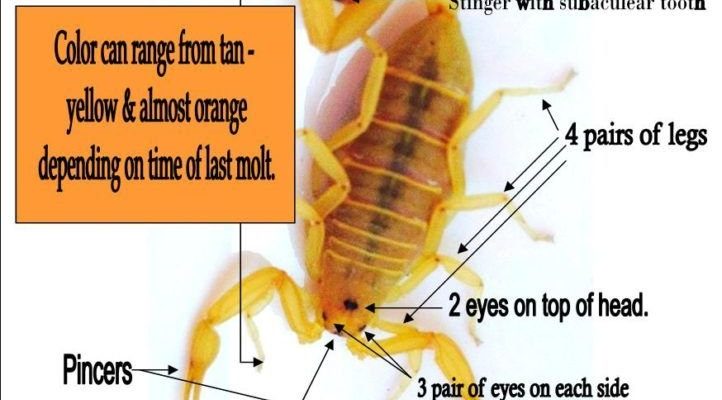
But here’s the good news: identifying the Arizona bark scorpion isn’t as daunting as it sounds. It’s all about knowing what to look for. Think of it like spotting a unique piece of art in a gallery. With the right knowledge, you’ll start to see the details that make it stand out. In this guide, we’ll explore its appearance, behavior, and habitat, along with some tips on how to stay safe if you happen to encounter one of these fascinating arachnids.
What Does an Arizona Bark Scorpion Look Like?
To start off, let’s dive into the appearance of the Arizona bark scorpion. As a beginner, you might think all scorpions look alike, but the Arizona bark scorpion has some distinctive features that set it apart.
First, these scorpions have a pale yellow or light brown body that can range from about 2 to 4 inches in length. Their exoskeleton can appear slightly glossy, adding to their somewhat otherworldly look. You might even catch them in a shaded area, where they can blend in with the desert floor. The Arizona bark scorpion also has a long, thin tail that is curved and tipped with a stinger, which is a key identifier. This tail can be a bit intimidating, but remember that it’s just a natural defense mechanism.
Another unique feature is their large pincers. Compared to other scorpions, the Arizona bark scorpion has relatively small claws, which are adapted for a more agile hunting style. Instead of crushing prey, they use their pincers to grab and hold onto insects. This can make them seem less fearsome, which is a good reminder that not all scorpions are out to get you.
Where Can You Find Them?
Understanding the habitat of the Arizona bark scorpion is just as important as recognizing its appearance. These scorpions are native to the southwestern United States, particularly in Arizona, but you can also find them in parts of California, Nevada, New Mexico, and Texas. Their preferred environment is rocky or sandy areas, often found in desert regions where they can hide under rocks or within crevices.
You might wonder, “What makes these places so appealing to scorpions?” Well, they thrive in warm climates and prefer areas with plenty of shelter to avoid daytime heat and predators. If you’re out in the desert at night, that’s when these critters become most active. They hunt for food, primarily insects, under the cover of darkness. If you’re looking to spot one, keep an eye out for them after the sun sets!
Behavior and Characteristics
Getting to know the behavior of the Arizona bark scorpion can help ease any worries you might have about running into one. Here’s the thing: they’re not aggressive unless threatened. If you encounter one, it’s usually best to leave it alone. When feeling cornered, they may sting to defend themselves, but this is generally a last resort.
One fascinating behavior to note is their climbing ability. Unlike many other scorpion species, the Arizona bark scorpion is quite adept at climbing vertical surfaces. They can be found on trees, walls, or even inside homes if they find a way in. This adaptability helps them hunt for food and find shelter, but it can also explain why you might unexpectedly find one inside your house.
Another interesting aspect of their behavior is their bioluminescence. Under ultraviolet light, these scorpions glow a bright blue-green! This unique feature is thought to help them with moisture retention or as a way to signal to mates. So, if you’re out for a walk in the desert at night with a UV flashlight, keep an eye out — you might just see one glowing in the dark.
What to Do If You Encounter One
If you do come across an Arizona bark scorpion, staying calm is key. Here are some steps you can take:
- Stay still: If you spot a scorpion, try not to make sudden movements. Most of the time, they’ll scurry away if left alone.
- Back away slowly: If you’re too close for comfort, slowly back away without turning your back on it.
- Do not provoke: Avoid trying to touch, move, or capture the scorpion. This could lead to a sting.
If you happen to get stung, it’s usually painful but not life-threatening. The sting can feel like a bee sting, causing redness and swelling. However, some people may have allergic reactions. If you experience severe symptoms, seek medical attention immediately.
Prevention Tips for Your Home and Yard
To avoid unwanted encounters with Arizona bark scorpions in your home or yard, consider these handy prevention tips:
- Seal entry points: Check for gaps in windows, doors, and walls. Sealing these can help keep scorpions out.
- Keep your yard tidy: Remove clutter, debris, and rocks from your garden where scorpions love to hide.
- Trim vegetation: Keep bushes and shrubs trimmed away from your home’s foundation.
Taking these simple steps can significantly reduce your chances of a scorpion surprise. Plus, a tidy yard looks nice anyway!
Myths and Facts About Arizona Bark Scorpions
There are plenty of myths floating around about the Arizona bark scorpion. Let’s clear up a few misconceptions:
- Myth: All scorpions are deadly.
Fact: While the Arizona bark scorpion has a potent sting, most scorpions are harmless to humans. - Myth: They are out to get you.
Fact: Scorpions generally prefer to avoid humans and will only sting if they feel threatened. - Myth: They glow in the dark to scare away predators.
Fact: The glow likely helps with moisture retention and mating.
Knowing the truth can help ease any fears and give you a better understanding of these fascinating creatures.
Identifying the Arizona bark scorpion can be both fascinating and essential. By understanding their appearance, behavior, and habitat, you can appreciate these desert dwellers while also knowing how to stay safe. Remember, they’re more scared of you than you are of them! So, whether you’re hiking in the desert or just enjoying your backyard, a little knowledge goes a long way in helping you feel at ease. Keeping your surroundings tidy and sealing entry points can help keep these critters at bay, ensuring you enjoy the beauty of Arizona’s wildlife without worry.

